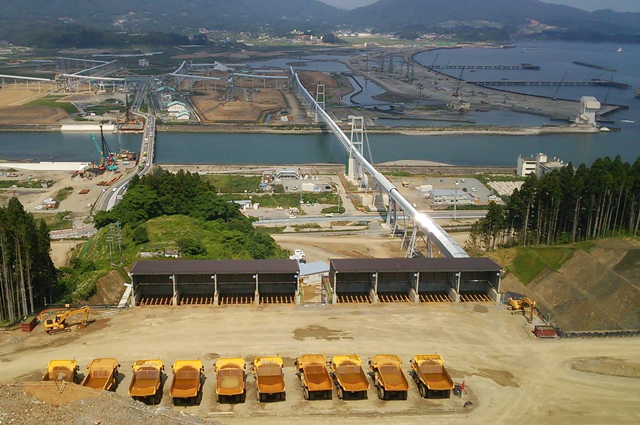As construction projects begin for Tokyo’s turn in the Olympic spotlight, the triple disaster recovery regions fall back into the shadow.
By Amya Miller
Visit Rikuzentakata and you will see a massive overhead conveyor system. With every trip to the city I see a new conveyor belt extended into the area that was downtown. This conveyor belt moves earth, millions of cubic meters of earth from nearby mountains into the city. We are tearing down mountains to create livable and buildable land so people can move out of temporary housing into their own homes. At the same time, we are raising the land of what was downtown, nine meters in some areas, eleven meters in others. For this, we need dirt. Without this conveyor belt, the removal of earth from the mountains across the river and into downtown would take ten years. With the conveyor belt system, we can do this in one. Here’s a massive project successfully bid upon and working. By next summer, the city is hopeful we can offer to residents land upon which they can rebuild homes. Not all in Rikuzentakata is hopelessness and doom.
But there is still so much work to be done. When cities, towns, and villages along 500 kilometers of coastline experience the damage that they have, rebuilding is a must. All of the cities affected by the tsunami from March 2011 have reconstruction projects at varying degrees of completion. Money for these projects has been allocated both by the central and prefectural governments. Companies can bid for the work, creating jobs for locals, or bring in their own crews if they’re not from the area. The number of projects available for bidding is endless. And yet, local municipalities grapple with the fact some contracts have no bidders. No bidders. The work is available. The money is available. Bid and there’s a good chance the job is yours. Rikuzentakata is no exception. With downtown gone—and the only permanent structure to be rebuilt to date a hotel—the list of what remains to be completed is long. Very long. Funds to rebuild are available. The need is obvious. Why then has only one building gone up? The answer is anything but simple.
Explanations range from “too much work and too few contractors” to “bidding only on the biggest of projects” to “lack of available hotels/housing for crew.” The truth probably lies somewhere between these and other reasons. Rikuzentakata has had to build living quarters for construction crews, a fancy version of temporary houses seen dotting the city. The number of watering holes available for an after-work beer can be counted on two hands. There’s nothing to do here. These facts lead to an ugly truth: with fewer companies bidding, reconstruction is slowing. Three-plus years post-disaster, Tohoku is becoming more and more forgotten.
When Tokyo was selected as the host city for the 2020 Olympics many in Tohoku were happy. Tourists would visit, leaving behind money, they thought. People from around the world would see the incredible progress being made, bringing back a sense of awe over Japan’s accomplishments.
Then there are those who wonder whether reconstruction will indeed be complete by 2020. If the current pace of construction is any indication, this is a valid question. The difficulties faced over lack of bids on construction projects will only continue, becoming more severe with time. Here is another way Tohoku bleeds. If projects in Tokyo are seen as more important than Tohoku recovery—the Olympics showing a more direct path to economic input into Tokyo—Tohoku reconstruction will continue to lag behind. Many in Tohoku feel like the unwelcome, unloved stepchild, always taking a back seat to the favorite—Tokyo.
Ask any Japanese politician and they will say Tohoku recovery is important for Japan’s future. Perhaps this is only lip service, elected officials saying what they must on air and in print. Those in the disaster areas want to believe that they matter. For disaster victims, recovery is a must. For that, cities need projects to be completed—land made available, schools rebuilt, city halls reopened, hospitals restored to functional condition—which brings us back to the Olympics. If reconstruction projects fall behind because of a lack of bidders now, won’t the Olympics make this worse? Many in Tohoku wonder.









